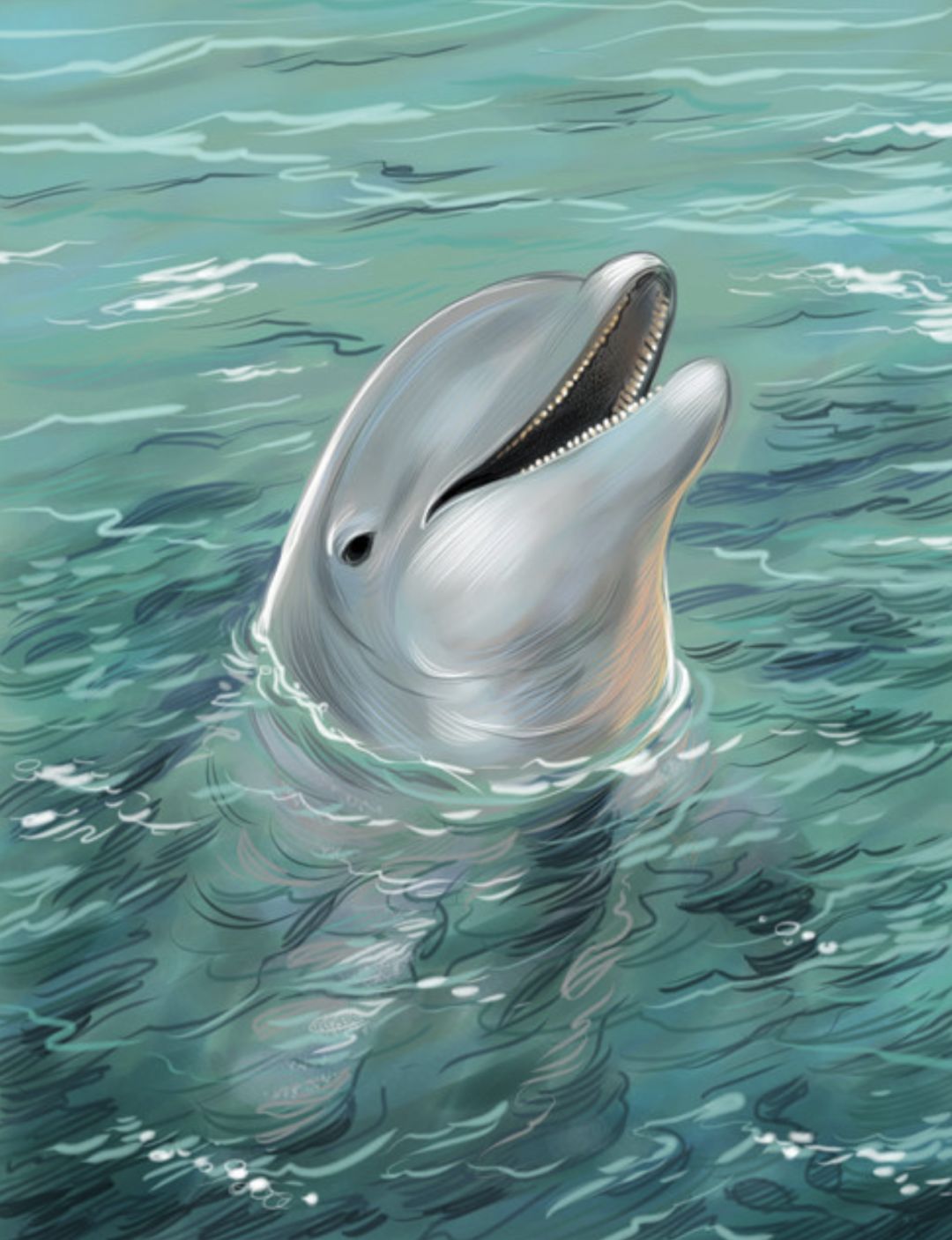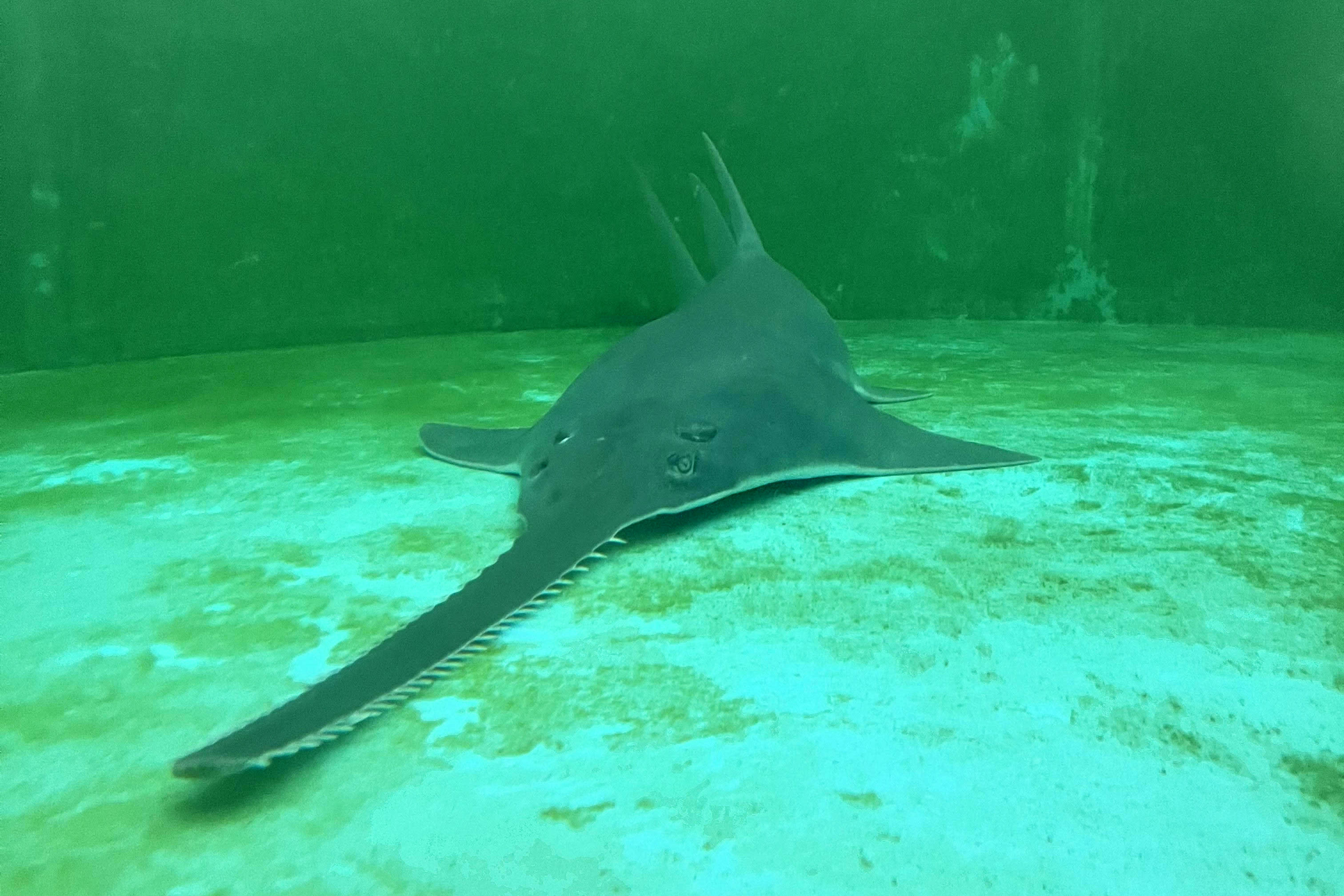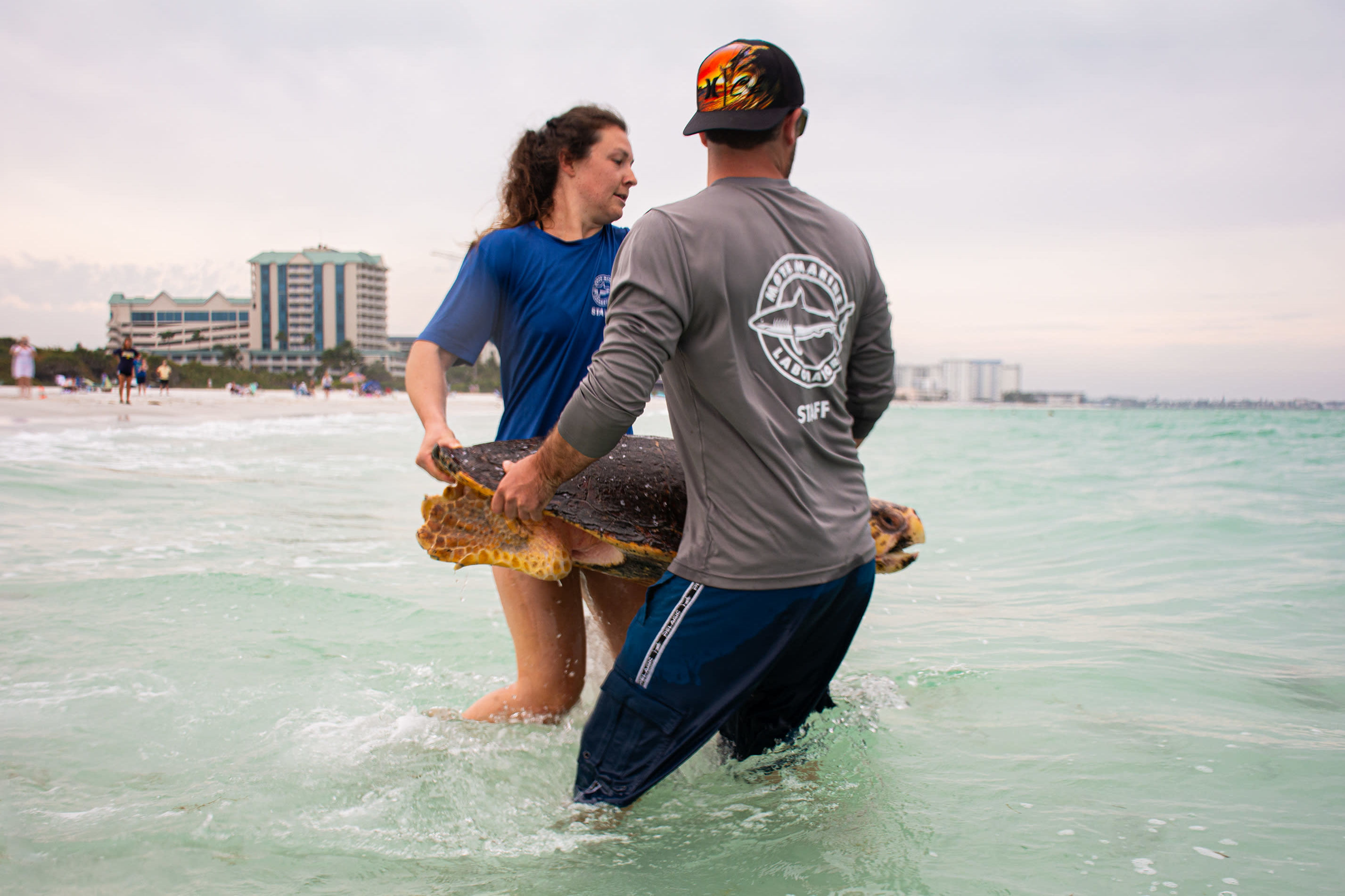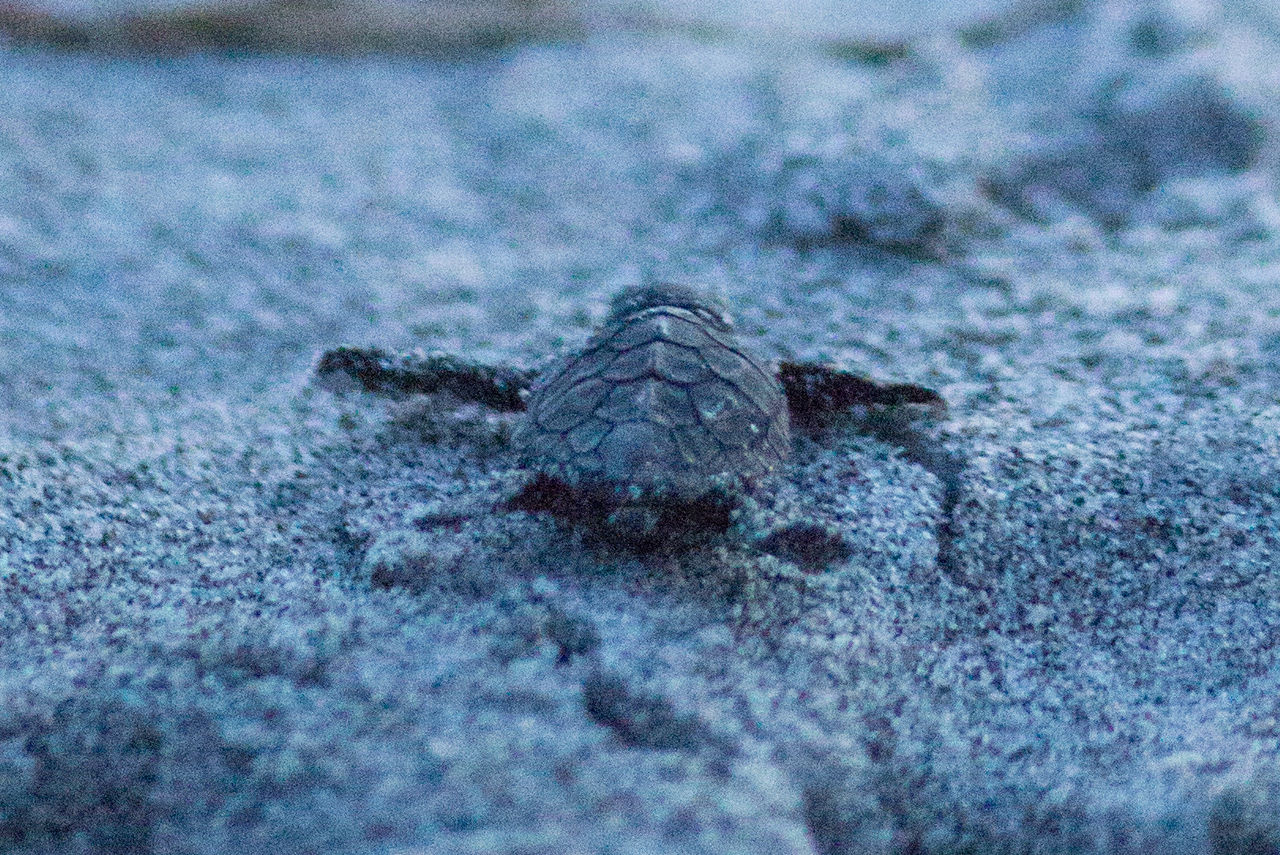Beggar the Dolphin: Loved to Death

Image: Tim Foley
The two Sarasota County deputies from the marine patrol division got the word about 5 p.m. on Friday, Sept. 12. A dead dolphin was floating near marker 15 north of the Albee Road Bridge. They had to go retrieve it.
After a 20-minute search, the deputies found the carcass. They put a rope on it and towed it to the boat ramp at Nokomis Beach. The dolphin had been dead for some time. That much was obvious. The body was bloated and sloughing off skin.
When dolphins wash up dead or injured along the coast, volunteers who are part of a network working with stranded marine mammals are called to collect them. Three members of Mote Marine Laboratory's stranding investigations team arrived at the Nokomis Beach boat ramp about 6:15 p.m.
They immediately recognized that the deputies had found Florida's most famous bottlenose dolphin since Flipper the television star.
The dead dolphin's name was Beggar. That was its claim to fame, too. Over more than two decades, Beggar had become widely known for panhandling the boats passing by in the Intracoastal Waterway.
Tourists and locals alike knew that if they rapped on the side of their boats, Beggar would swim up, thrust a smiling snout out of the water and beg for food. Pictures and videos of Beggar circulated widely on the Internet—jumping, snatching a tossed fish from the air, shooting through the water in hot pursuit of a speeding boat, swimming mere inches from the spinning propellers, risking life and fin in hopes of earning handouts.
Many boaters threw fish to Beggar, but some tossed more exotic fare.
"Researchers have spotted people feeding him potato chips, macadamia nuts, oranges and apples as well as rotting shrimp, squid and other fishing bait that reek with bacteria," an official Mote report noted.
The stranding team members trucked the carcass back to the Mote Marine laboratory on City Island. They wanted to figure out what had killed the celebrity dolphin. As humans undergo an autopsy, so animals are cut open for what's known as a necropsy. The necropsy for Beggar began about 7 p.m. and ended eight hours later.
In one way, the necropsy results were inconclusive. Biologists found nothing they could call the cause of Beggar's death. But in another way, the necropsy confirmed every suspicion that dolphin experts ever had about Beggar, and about the people enthralled by his antics.
They found multiple broken bones and vertebrae, as well as several healed wounds on his fins and skin—signs that Beggar had gotten a little too close to the boats of all those admiring fans and suffered the consequences.
And inside, in Beggar's three stomachs, they found something even more disturbing: three fishing hooks, small bits of line and two squid beaks. Sarasota-area dolphins don't normally eat squid, so it was clear that Beggar had been stealing the bait from local anglers, along with the hooks and line that went with it.
The biologists could see that Beggar was markedly dehydrated—a remarkable finding for an animal spending its whole life in the water. And instead of a normal weight of nearly 500 pounds, he weighed in at just 300 pounds, probably a result of not pursuing and eating the fish that constitute a normal dolphin diet, and in a quantity that normal dolphins consume.
To the biologists studying the marine mammal's emaciated remains, the evidence was clear as could be about who killed Beggar: all those fans who tossed food to the star. Said Stacey Horstman, bottlenose dolphin conservation coordinator for the National Oceanic and Atmospheric Administration: "Every time a hand reached out to Beggar, it contributed to his death."
Randy Wells has spent three decades studying the dolphins that swim around Sarasota. The first time he saw Beggar was Aug. 10, 1990. The young dolphin had already perfected its performing routine.
The encounter, as with nearly all encounters with Beggar, occurred in the Intracoastal Waterway just north of Albee Bridge. The waterway narrows here between Casey Key and the mainland, funneling boaters down into something like single file. There's a drawbridge to negotiate, too. And because the area is designated as manatee habitat, boaters are supposed to slow down to idle speed.
On that late summer day, Wells recalled, he and other dolphin researchers from Mote were cruising along slowly when a young dolphin swam up next to their boat and popped open its mouth, precisely imitating a baby bird asking to be fed by its mama. They had never seen anything quite like it in the wild.
"We were surprised," Wells, director of the Sarasota Dolphin Research Program at Mote, says. "We thought he was more of an anomaly than he turned out to be."
Wells and his colleagues jotted down the obvious name for this newly identified dolphin, then set about trying to figure out where it had learned to panhandle.
They figured this youngster had either escaped or been released from captivity somewhere along the Gulf coast. It must have come from a place that copied the SeaWorld formula of entertaining ticket buyers with a choreographed dolphin show. But when they contacted the places that featured performing dolphins, no one admitted to having one missing, Wells says.
Ultimately, they concluded that Beggar was not trained as a performer. Instead, Wells explains, Beggar was a wild dolphin that had learned how to coax people to toss out food. In a way, Beggar had trained the humans, not the other way around.
The young dolphin's primary range included an area where lots of boats passed by that contained generous humans. They saw the smiling young dolphin and tossed him some fish, a tribute to his cuteness. Soon enough, Wells says, Beggar "figured out that food from people was easier to come by" than chasing it down and catching it, the way most dolphins do.
Soon, Beggar had picked up a companion. Beginning in 1993, Beggar was paired up with another begging male that the scientists named "Mooch." They worked together for about three years, and then Mooch moved on or died, no one knows for sure. But Beggar stayed put, still working the same stretch of waterway.
From time to time, Beggar popped up with a female companion named Bardot. Bardot had also learned to solicit food from passing boats, probably from watching Beggar at work. Bardot had a calf that also picked up the begging habit. When it died in 2000, at four years old, the calf was emaciated. A necropsy found the calf had fish hooks in its stomach, line entanglement scars on all of its fins, a shark bite scar, and fresh, deep, boat propeller wounds on its tail stalk. Bardot's calf "was a poster child for all that could go wrong from interactions with humans," the Mote report on Beggar noted.
In 2005, when red tide devastated the fish population in Sarasota Bay, more dolphins turned to taking handouts or seizing the bait from anglers' lines. Meanwhile, the more biologists looked, the more begging behavior they had begun seeing among wild dolphins—and not just around Sarasota.
From North Carolina down to the Keys and all along the Gulf coast, Horstman said, "Wherever we have dolphins and people there, we're seeing increased reports of human interactions with dolphins—feeding them, trying to touch them, swimming with them."
Such behavior hasn't been confined to the United States, either. In Australia biologists spent a decade studying bottlenose dolphins in the bay off Perth and watched the number that begged for food go from one to 14. The dolphins, which live amid a complex social structure, taught each other how to beg. The ones that begged for food tended to be the ones that wound up being hit by boats.
That's the thing about these handouts. They draw wild animals in close enough to humans for them to get hurt or killed.
All around the Florida coast are well-meaning waterfront homeowners who stand on their docks and use a hose to spray water into the mouths of manatees. They think they are doing something nice for the manatees. They never consider whether it's wise to get manatees in the habit of congregating around docks where boats also tend to congregate.
What's true on the water is true on land. In the Florida Keys is a colony of about 700 deer that are the size of big dogs. This species has been on the endangered list since 1967. The Key deer are so petite and appealing that tourists driving through the National Key Deer Refuge can't resist rolling down their windows and offering them treats.
The Key deer now associate cars with food. Whenever they see a car they run up looking for a handout. As a result, the leading cause of death for Key deer is being run over by vehicles.
Dolphins and manatees and Key deer are the victims of their own appealing looks. The dolphin's smile hides so much about them. People see that smile and think the dolphin is always friendly, always eager to please a human.
The problem is, some people can't just watch a wild animal being wild. Like the woman in St. Petersburg who spotted a passing manatee at the beach and tried to ride it, they want to be more than passive observers. They have to put themselves into the picture somehow, make themselves the star of this nature show.
"People just can't resist feeding the dolphin or petting the dolphin," one Sarasota-area tour boat operator told the Tampa Bay Times after Beggar's death. "You don't go hiking in the Rockies and see a grizzly bear and walk up and try to feed it. But dolphins are characterized so differently in movies, people think it's going to be just like a puppy. So they just go up and try to pet it."
Just as Beggar got in the habit of taking handouts, people have been conditioned to think that way by repetition. They've seen the dolphins at SeaWorld leaping on command and being tossed their rewards by human handlers. They've been to the dolphin feeding areas at the theme parks. They've seen Flipper on TV. They think they know what dolphins want and how to react to them.
Until the teeth clamp down on their skin, that is.
"In Beggar's defense," Wells says, "he only used the teeth when people weren't feeding him."

For three months in 2011, from March to June, Mote Marine's Dr. Katie McHugh spent 100 hours watching Beggar's behavior. In that time, she documented 3,600 times that Beggar had some sort of interaction with humans. Mostly she saw people trying to attract Beggar's attention, then tossing fish and other food.
But 121 times, people wanted to do something more intimate. They wanted to touch Beggar, to pat the dolphin's head the way they would a dog's, to stroke its skin as if it were a cat.
Nine times, that ended with Beggar biting the human. The dolphin wanted food, not affection, and exhibited little patience with those who showed up empty-handed.
"People see that smile and they assume it indicates friendship," Wells says. Instead all a dolphin's smile indicates is that dolphins have 100 or so teeth.
A bottlenose dolphin's teeth are not razor sharp. Their teeth are cone-shaped and wear down over the years. The dolphins use them for grasping their prey, not for chewing them up or ripping them apart, Wells explains.
"Once they grab a fish, they typically maneuver it to be able to swallow it, intact, head first," he says. "If they catch a fish that is too large to swallow, they may drag it along the bottom or shake their heads to try to tear the fish into smaller pieces." Still, he says, if someone whose hand wound up trapped in a dolphin's mouth were to try to snatch it back, "They would be lacerated."
Over 20 years, Beggar bit plenty of would-be admirers, administering a stiff penalty to anyone who failed to pay tribute. But nobody got it worse than Kim Foy.
In July 1992, she was boating with her family in the Intracoastal Waterway, tossing bait to a dolphin that Wells believes was Beggar.
Then she and her eight-year-old son jumped into the water to cool off. Meanwhile the occupants of another boat "started teasing the dolphin by holding a shoe above the water as if it were food," the Sarasota Herald-Tribune later reported.
Suddenly Foy felt the dolphin's teeth chomp down on her knee. She broke free, but then the dolphin clamped down on her son. Foy's husband, Edward, was able to lean out of the boat, yank the boy loose and haul him to safety.
Still on the attack, the dolphin grabbed Foy's leg again. This time, no matter how she struggled, she could not get loose. Her husband jumped into the water and kicked the dolphin in the face, forcing it to let go, and then helped her climb back aboard the boat, blood welling from her leg.
Foy's wound took 20 stitches to close. The next day, her leg swelled up. She had contracted a cholera infection. Doctors said they couldn't tell if it was caused by pollution in the water or contamination from the dolphin's bite. She spent a week in the hospital recovering.
Before the attack, Foy regarded swimming with the dolphins as "neat," she told CBS News in 2009.
She remembered thinking, "This is just like Flipper on TV."
Not anymore, she said. Even 17 years later, "I still think about the pressure of the jaws around my leg and pulling me down," she told the TV camera. "It was a horrible experience."
For about a year in the late 1990s, Wells and a team of researchers from Mote spent hours on end watching how passing boaters behaved when they encountered Beggar. They saw more than 8,000 boats. They watched 68 boaters toss food to the dolphin and saw 80 try to touch or pet it. They saw 18 get bitten and heard about 10 more bites.
As part of their research, the Mote crew approached 173 boaters to tell them that what they were doing was illegal. Under the federal Marine Mammal Protection Act, feeding and teasing a dolphin constitute harassment. Violations can bring a fine of up to $20,000 per incident, plus a year behind bars.
Of the 146 boaters who agreed to talk to them, they found that 61 percent knew that feeding dolphins was wrong and yet they did it anyway.
Even having a state wildlife officer on patrol nearby didn't discourage them much. "While the officer was talking to the occupants of one boat about the dangers of feeding wild marine mammals, other boats engaged in feeding interactions with the dolphin," the study reported.
That should come as no surprise. Panama City has been the capital of the tours that allow paying customers to swim with the dolphins. Tour operators who wanted to make sure their customers got a good show would regularly toss fish to the dolphins. Two of the tour operators in Panama City and one in Cape Coral were hit with $5,000 fines by the National Oceanic and Atmospheric Administration last summer.
Yet when federal officials surveyed Panama City tourists, residents and businesses in 2011, they found that the people who already knew about the law against feeding dolphins also didn't take it seriously. They didn't see any harm in what they were doing.
To biologists the harm is obvious: Feed a dolphin and you alter its behavior. Mothers compete with their own calves for food instead of showing them how to hunt. Animals that should shy away from boats swim up under spinning propellers. Wild creatures lose their healthy fear of humans. The result is predictable. So far this year six dolphins along the Gulf coast have been killed violently. One was shot. One was stabbed with a screwdriver. One had had its lower jaw ripped off.
So to Wells and the other biologists who studied Beggar's death, there was no real mystery about what had killed Florida's most famous dolphin since Flipper. The real mystery was why the people who say they adore dolphins so much were the ones most at fault.
"They just love these animals so much," Horstman says, "and they don't recognize how feeding a wild animal can kill an animal."
Tampa Bay Times reporter Craig Pittman has won the Waldo Proffitt Award for Distinguished Environmental Journalism in Florida four times, and twice won the top investigative reporting award from the Society of Environmental Journalists. Stories he has written for Sarasota Magazine have won three first-place Charlie Awards from the Florida Magazine Association. His book, The Scent of Scandal: Greed, Betrayal, and the World's Most Beautiful Orchid, grew out of one of those stories.



